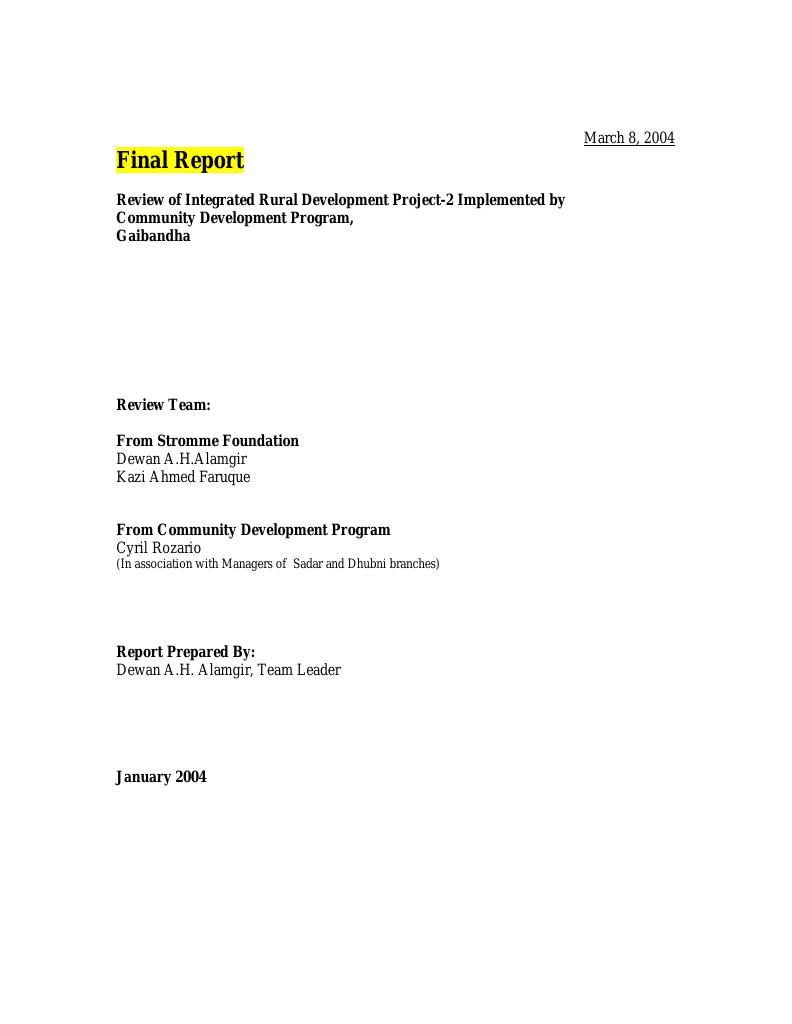Evaluering
Integrated rural development Project 2” in Gaibandha district
Background The Community Development Programme (CDP) has been working in Gaibandha since 1984 and Stromme Foundation (SF) has been supporting CDP's five year "Integrated Rural Development Project- 2" since 1999 which includes institution building, microfinance, sanitation awareness and disaster preparedness awareness building. A midterm review was conducted in July 2002 and this is the end of project review. Purpose/objective With the change of SF policy on project financing to emphasizing more on organizational development, the purpose of the current review therefore was on assessing (a) institutional capability and (b) project performance covering the five year project 1999-2003. Methodology The evaluation was more of a review based on discussion and observations of the activities of CDP in two areas Gaibandha Sadar and Dhubni branch area, than a rigorous quantitative evaluation of the project. Discussions were held with members at group meetings to collect their views about the program activities and their impact with staff members in two branches and Head Office also to gather their views about the program management and impacts, besides studying Project documents: proposals and annual reports, audit reports, previous evaluation report and the Accounting and MIS system. Key findings The focus of CDP has been formation of groups for implementing development activities such as microfinance, sanitation awareness and disaster preparedness. However CDP has been concentrating more on microfinance whereas the other two areas: sanitation and disaster preparedness has remained limited to discussions on these issues at group meetings.i) Target groups and outreach: CDP has been successful in reaching out to very poor households but poor loan recovery rate compels CDP to move away from the target group.ii) Loan recovery rate and portfolio quality: CDP has failed to maintain the required recovery rate; the overall loan recovery rate was 69%, a rate which is not acceptable for any well performing MFI. Unless CDP dramatically improves its portfolio quality it will be extremely difficult to maintain the program.iii) Savings mobilization: The programme has Taka 4.46 million as savings and to increase funds it has introduced four different savings products for 7 and 14 years period. The drive to improve funding situation, it is risky and expensive for a small and financially unviable NGO like CDP to1venture into long-term deposit mobilization from members. It is should be more viable and reasonable to try to improve the portfolio quality.iv) Credit products: CDP provides one loan per year with current average loan size being Taka 4,000. The staff not having conducted due diligence when selecting borrowers and estimating amount of loan needs of members it has led to disbursement of loan amounts larger than necessary, which is one of the reasons from poor recovery rate.v) Management: It has improved credit policies, and possessed good accounting, internal control and management information system.vi) Impact of microfinance program: Areas of impact as reported by the members at the group meetings during the visits are summarized below:• Members' dependence on moneylenders has been reduced.• Members could begin some income generating activities as well as expand existing businesses by accessing loans from CDP. This has created employment opportunities.• Members have the opportunity to save regularly and can access their savings in case of emergency.• Members reported increase in income which has helped them acquire assets. Some members have improved their houses. ConclusionsCDP is facing a serious financial crisis due to its poor portfolio quality, poor recovery rate and gradually declining credit funds. It has taken some steps to improve the situation but success of its drive to improve the program very much depends on the ability of the branch managers and field workers. Extra resources will be necessary to maintain the disbursement level, which could assist the recovery drive. Recommendations i) Microfinancea) Improve the loan recovery rate and quality of portfolio by recovering default loans.b) Raise additional funds to maintain the level of disbursement for the three branches to make the present scale of operation of CDP financially viable.c) Introduce appropriate loan loss provision.d) Use simple but effective indicators such as attendance rate, regularity of savings and loan recovery rate to monitor the performance of groups.e) CDP should be very cautious in introducing long-term savings. This may be risky for an unsustainable organization like CDP, whose loan operation is far below desirable level.ii) Human Resources DevelopmentAdditional training on microfinance development should be given to staff members.iii) Role of Stromme FoundationFrom a lender's point of view the program of CDP is unviable given the quality of portfolio. Unless CDP dramatically improves its portfolio quality, it is recommended that SF considers stopping lending to CDP. Comments from the organisation In spite of failings with the first IRDP I project, SF decided to give CDP a second chance and started the second project (IRDP II) in a new area. In spite of all efforts CDP continued to fail in the project implementation. SF allowed CDP to recover loans that were defaulting in microfinance during 2005 without any additional credit input (as recommended in the evaluation report) and guiding it to salvage the microfinance field situation but it was unable to do so. Therefore at end of 2005 the project was officially dropped from SF support.
